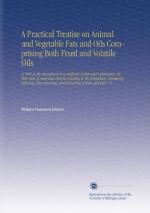|
This section contains 1,007 words (approx. 4 pages at 300 words per page) |

|
Fats and oils are a broad class of animal and vegetable compounds which are used in products such as foods, cleansers, and lubricants. They are members of the lipid family and are energy-rich compounds that are basic components of the normal diet. Fats and oils have essentially the same chemical structure--a mixture of fatty acids combined with glycerol (a trihydroxy alcohol) and are similarly insoluble in water. However, while fats remain solid (or semisolid) at room temperature, most oils very quickly become liquid at increased temperatures. Unfortunately, this definition can lead to confusion with petroleum and essential oils. Therefore chemists have begun to classify both as fats. Animal fats and oils include butter, lard, tallow and fish oil. Plants provide a number of oils, such as cottonseed, peanut and corn oils.
The fundamental nature of natural fats and oils was determined almost two hundred...
|
This section contains 1,007 words (approx. 4 pages at 300 words per page) |

|


